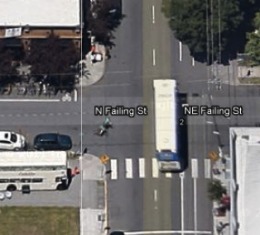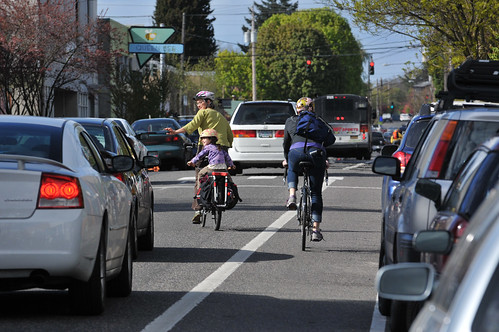
During the monthly stakeholder advisory committee meeting for the North Williams Traffic Operations Safety Project today, PBOT announced that it’s “unlikely” they would be willing to redesign the street in the section between N Cook and Skidmore (known as Segment 4) into a one-lane configuration for auto traffic.
Segment 4 — which currently has two standard vehicle lanes, one bicycle lane and two auto parking lanes — is the highest traffic section of the project area with between 950 to 1,100 autos and 400 bicycles during peak hours.
PBOT’s announcement, made by project manager Ellen Vanderslice, is a shift from their previous position.
Back in May 2011, city traffic engineers concluded that reconfiguring this section of Williams to one lane for auto traffic could be done with no increase in congestion. PBOT also made that determination based on community feedback in favor of making Williams one lane for auto traffic in order to improve bike access. PBOT had hoped that signal timing changes could yield more “green time” on Williams and thus make up for the lane reduction.

(Photo © J. Maus/BikePortland)
Today, Vanderslice went through a segment by segment tour of the project. On the slide for Segment 4, under the heading of “Constraints,” PBOT explained that “auto traffic is high enough that two travel lanes are likely needed during peak hour.” In the other four segments, PBOT says a one-lane configuration is still possible.
“Early on, we thought signal changes could get us more capacity; but with development occurring it’s unlikely we could ever go to one lane in this area.”
— Ellen Vanderslice, PBOT
In addition to auto traffic volumes, auto parking availability is also a major concern for PBOT and some stakeholders. This issue has been exacerbated with several new developments happening on the street (one apartment complex is nearing completion, another is on the way, and New Seasons will be built just to the south).
Addressing the committee today, Vanderslice said, “Early on, we thought signal changes could get us more capacity; but with development occurring it’s unlikely we could ever go to one lane in this area.”
Committee member Michelle DePass repeatedly brought up parking demand concerns. She said with two new apartment buildings and New Seasons on the horizon, more parking will be needed. “Keep in mind that many of the people moving into these places will probably have cars.”
It’s important to remember that PBOT initially approached this project with a reluctance to change Williams to one auto lane in Segment 4; but after they heard loud and clear from the public that a wider bikeway and a one auto lane configuration was preferred, they seemed poised to move forward with the one-lane solution. The Bicycle Transportation Alliance (BTA) was also ready to launch an advocacy campaign in favor of one lane on Williams.
That was mid-May of last year. Then, less than one month later, the project was put on hold due to concerns by some in the community that not everyone’s opinion was being heard.
At the SAC meeting today, Vanderslice didn’t completely rule out the possibility of one auto lane. “It doesn’t mean we couldn’t do one lane,” she said, “but it means if you did you’d likely be pushing people to other facilities or they’d be waiting in traffic.”
It was my sense from being on the sidelines of the SAC meeting today, that there remains a wide difference of opinion among committee members about this lane issue. It will be interesting to see how this discussion evolves (or if it does at all).
The SAC is still debating various design solutions for the project and their goal is to issue a resolution to City Council by March 6th.
— For more on this project, view our past coverage.

